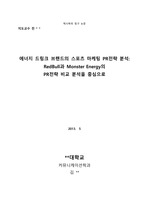

-
미리보기
소개
에너지 드링크 브랜드의 스포츠 마케팅 PR 전략 분석 : RedBull 과 Monster Energy 의 PR 전략 비교 분석을 중심으로목차
I. 서론
1. 연구 목적
2. 연구 배경
II. 이론적 배경
1. 기업 PR 의 이해
2. 스포츠 스폰서십 PR 프로그램의 이해
III. 본론
1. 레드불
1) 기사보도화 전략
2) 스폰서십
3) 이벤트 개최
2. 몬스터 에너지
1) 기사보도화 전략
2) 스폰서십
3) 이벤트 개최
3. 스포츠 마케팅 PR PR PR 전략 분석
1) 공통전략
2) 레드불과 몬스터 에너지 PR 활동의 차별점 차별점
3) PR 3) PR전략의 실행 효과
IV. 결론
V. 참고문헌본문내용
1. 연구 목적
실외광고 환경과 프로모션 전략들의 변화는 전통적 마케팅 방식에 도전하고 있으며, 소비자 행동에 대한 브랜드 노출의 효과는 급격히 중요한 연구분야가
되었다. 레드불과 몬스터 에너지(Monster Energy)는 다양한 이벤트와 PR방식을 통해 단순한 음료 제품을 생산하는 기업이 음료 시장을 넘어 다양한 문화 산업을 후원하고 스포츠 이벤트 등의 PR 전략을 펼치고 있다.
. 명성관리와 이슈 관리, 그리고 위기 관리라는 상황 분석과 이를 통해 Corporate Public Relation과 Marketing Public Relation을 나누어 언론관계, 정부관계, 지역사회관계, 투자자관계, 종업원관계의 CPR차원과 소비자 관계라는 MPR차원으로 대중을 분리하여 두 회사의 Public Relation Program이 어떻게 효과적으로 작용하여 단일 제품을 생산하는 음료 브랜드가 전세계의 스포츠와 대중문화에 깊이 관여하여 브랜드의 가치를 형성하였는가에 대한 연구를 통해 다양한 스포츠 PR전략 구성 및 실행의 효과와 가능성을 연구해 보고자 한다.
본 연구는 다양한 스포츠 종목의 선수를 후원하고 특히 비주류 스포츠인 익스트림 스포츠와 액션 스포츠의 유망 선수를 육성하는 두 음료 회사의 PR전략에 대한 연구를 통해 효과적 스포츠 PR커뮤니케이션 채널을 활용하여 단순 음료를 판매하는 것을 넘어 새로운 문화를 형성하고 있는 두 브랜드의 스포츠 PR전략을 집중적으로 알아보려 한다.
특히 이 연구는 PR커뮤니케이션 시스템의 스폰서쉽과 이벤트, PPL에 대하여 두 브랜드가 펼치고 있는 다양한 사례들을 비교하여 PR의 방법과 효과를 실증적으로 분석하고자 한다. 특히 이들 두 에너지 드링크 사가 진행하는 스폰서쉽 스포츠의 범위를 분석하여 두 브랜드의 이미지에 따른 스폰서쉽 방향과 그 효과를 파악해볼 것이다.참고자료
· 고은하 (2011), 감정적 몸과 민족주의: 미디어를 통한 셀레브리티 몸의 소비와 재생산, 한국
· 스포츠사회학회지 제24권 제1호, p.63-78
· 구윤희, 심재철 (2007), 월드컵 스폰서십과 매복마케팅: KTF의 2002 월드컵과 2006 월드컵
· 기업PR 사례연구
· 김민철 (2011), 스포츠마케팅을 활용한 성공적인 경영성과 사례연구 : 현대카드 슈퍼매치
· (Super Match)를 대상으로, 한국사회체육학회지 제46호, pp. 221~236
· 김완석 (2000), 광고심리학, 서울, 학지사. P10-55
· 김요한 (2010), 스포츠 관여도와 스폰서-이벤트 간 관련성이 스폰서십 효과에 미치는 영향
· 스폰서십에 대한 신념, 스폰서 동기 지각의 매개역할을 중심으로, 홍보학 연구,
· Vol.14, No.3 p10, 11
· 김한주, 옥정원, 허갑수 (2011) 스포츠팬 관람동기의 다차원적 구조가 팀 애착 및 스폰서십
· 효과에 미치는 영향에 관한 연구: 자기결정성 이론을 중심으로, 한국광고홍보학회,
· 제13권 1호
· 옥정원 (2003). 팬덤 동일시가 팬덤 후원 기업에 대한 태도에 미치는 영향. 미출간 석사학
· 위논문, 부산대학교
· 유상건&폴 피터슨, 스포츠 커뮤니케이션; 한국의 스포츠를 움직이는 사람들 (2012), , 레인
· 보우 북스
· 주지혁, 최명일(2005), “스포츠 선수-스폰서 연계성이 스폰서링 동기 및 스폰서 태도에 미
· 치는 영향: 스폰서십 지식의 조절효과를 중심으로”, 『한국광고홍보학보』, 7(3),
· pp.85∼110.
· 한규훈 (2008). 소비자특성이 스포츠이벤트 마케팅에 대한 태도에 미치는 영향. ≪한국광고
· 홍보학보≫, 10권 2호, 124∼149
· 황정호&전종우, (2011), 공식스폰서와 앰부시 마케팅의 광고 크리에이티브 효과: 2010 광저
· 우 아시안게임을 중심으로, 한국광고홍보학보 13(4)
· Antil, J. H. (1984). Conceptualization and Operationalization of Involvement. Advances in
· Consumer Research, 11, 203∼209.
· Bennett, R. (1999). Sports Sponsorship, Spectator Recall and False Consensus. European
· Journal of Marketing, 33(3/4), 291∼313.
· Brenda M Malinauskas, Victor G. Aeby, Reginald F. Overton, Tracy Carpenter-Aeby and
· Kimberly Barber-Heidal (2007), A survey of energy drink consumption patterns
· among college students, Nutriation Journal. 6: 35.
· D’Ydewalle, G., Abeele, P. V., Rensbergen, J. V. & Coucke, P. (1987). Incidental processing of
· advertisements while watching soccer game broadcasts
· Dees, W., Bennett, G., & Villegas, J. (2008). Measuring the Effectiveness of Sponsorship of an
· Elite Intercollegiate Football Program. Sport Marketing Quarterly, 17(2), 79∼89.
· Eagleman, A.N, Pedersen, P. M, & Wharton, R. (2009). The coverage of genter in ESPN The
· Magazine: An examination of articles and photographs. International Journal of
· Sports management (IJSM) 10(2), p.226-242
· Gupta, P. B., & Lord, K. (1998). Product Placement in Movies: The Effect of Prominence and
· Mode on Audience Recall. Journal of Current Issues and Research in Advertising, 20,
· 47∼59.
· Gwinner, K., & Swanson, S. (2003). A Model of fan identification: Antecedents and
· sponsorship outcomes. Journal of Services Marketing, 17(3), 275∼294.
· Havitz, M., & Mannell, R. (2005). Enduring Involvement, Situational Involvement, and Flow in
· Leisure and Non-leisure Activities. Journal of Leisure Research, 37, 152∼177.
· Hirt, E. R., Zillmann, D., Erickson, G. A., & Kennedy, C. (1992). Costs and Benefits of
· Allegiance: Changes in Fans’ Self-ascribed Competencies after Team Victory versus
· Defeat. Journal of Personality and Social Psychology, 63,724∼738.
· Krugman, H. E. (1965). The Impact of Television Advertising Learning without Involvement.
· Public Opinion Quarterly, 29, 340∼359.
· Levin, A. M., Joiner, C., & Cameron, G. (2001). The Impact of Sports Sponsorship on
· Consumers’ Attitude toward the Sponsors and Recall: The Case of NASCAR Fans.
· Journal of Current Issues and Research in Advertising, 23(2), 23∼31.
· McIntyre, N., & Pigram, J. J. (1992). Recreation Specialization Reexamined: The Case of
· Vehicle-based Campers. Leisure Research, 14, 3∼15.
· Meenaghan, T. (1983). Commercial Sponsorship. European Journal of Marketing, 17(7),
· p5∼73.
· Meenaghan, T. (2001). Understanding Sponsorship Effects. Psychology and Marketing, 18(2),
· 95∼122.
· Sherif, M., & Cantril, H. (1947). The Psychology of Ego-involvement. NY: John Wiley & Sons,
· Inc.
· Wilcox, D. L., Ault, P. H., & Agee, W. K. (1999). Public relations strategies and tactics. Boston,
· MA: Allyn and Bacon.
· http://www.monsterarmy.com
· http://www.monsterenergy.com/us/en/sports/
· http://www.redbullstratos.com
· http://www.redbullstratos.com/technology, http://dicagallery.com/140170567097, ‘기술소개’
· 부문 인용
· http://www.redbullstratos.com/the-mission/drop-zone-winners/
· http://www.scottsports.com/winter 참조태그
-
자료후기
Ai 리뷰판매자가 등록한 자료를 통해 새로운 인사이트를 얻고, 과제의 내용을 보강하는 데 큰 도움이 되었습니다. 정말 추천할 만한 자료입니다! 감사드립니다. -
자주묻는질문의 답변을 확인해 주세요

꼭 알아주세요
-
자료의 정보 및 내용의 진실성에 대하여 해피캠퍼스는 보증하지 않으며, 해당 정보 및 게시물 저작권과 기타 법적 책임은 자료 등록자에게 있습니다.
자료 및 게시물 내용의 불법적 이용, 무단 전재∙배포는 금지되어 있습니다.
저작권침해, 명예훼손 등 분쟁 요소 발견 시 고객센터의 저작권침해 신고센터를 이용해 주시기 바랍니다. -
해피캠퍼스는 구매자와 판매자 모두가 만족하는 서비스가 되도록 노력하고 있으며, 아래의 4가지 자료환불 조건을 꼭 확인해주시기 바랍니다.
파일오류 중복자료 저작권 없음 설명과 실제 내용 불일치 파일의 다운로드가 제대로 되지 않거나 파일형식에 맞는 프로그램으로 정상 작동하지 않는 경우 다른 자료와 70% 이상 내용이 일치하는 경우 (중복임을 확인할 수 있는 근거 필요함) 인터넷의 다른 사이트, 연구기관, 학교, 서적 등의 자료를 도용한 경우 자료의 설명과 실제 자료의 내용이 일치하지 않는 경우
찾으시던 자료가 아닌가요?
지금 보는 자료와 연관되어 있어요!
문서 초안을 생성해주는 EasyAI







